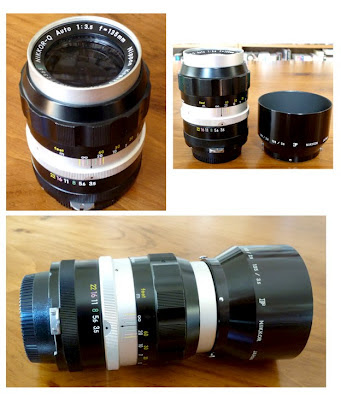
I've been looking at older, non-AI, Nikkor glass for some time. These lenses tend to be quite rugged and the glass elements have a single coating as opposed to lenses made today which have multiple coatings that reduce lens flare and other "undesirable" effects. However lenses with single coatings often render a range of tonality and color temperature that's impossible to achieve with contemporary multicoated lenses. Multicoated lenses also tend to render images much higher in contrast than single coated lenses.
Lately I've been interested in early 105mm and 135mm Nikkor lenses. I've been carefully watching the stock at KEH for some months, looking for pieces in good condition and within my almost nonexistent budget. KEH's grading system: Like New to Ugly, is very reliable. There are times when an item will be rated at the bargain grade because of cosmetic imperfections. The item is actually flawless mechanically or optically but the price is low because it isn't really pretty. Other pieces that are rated bargain grade may indeed have some flaws other than cosmetic but nothing that would compromise image making quality. (For example a while back I bought a bargain grade Nikkor non-AI 28mm f/3.5 for $30. Optically it's beautiful, but the aperture ring is squeaky.)
The other day as I scrolled through the KEH stock I found this Nikkor-Q 135mm f/3.5 lens, with an AI conversion, in Excellent condition for $39. Now here's the key, there were other identical lenses in excellent condition listed that were more expensive, but the fact that a previous owner had performed his own custom AI conversion on this lens made it less than perfect. (AI conversions usually require the milling or cutting down of a portion of the lens' metal aperture ring to accommodate the little tongue on the Auto Index cuff surrounding the lens mount on newer auto exposure capable Nikon cameras.)
For me the AI conversion is a real value. It means I can put this lens on my F100 and it will couple perfectly with the camera's metering system. It took less than a minute of thought for me to click the "Add to Cart" button.
I knew I wanted a lens hood for this lens as I use lens hoods to protect the front elements of my lenses and the hood will help reduce the possibility of lens flare which single coated lenses don't handle well. With a few more clicks I found the appropriate lens hood also in Excellent condition for $7. (A few months ago a camera shop owner here in San Francisco offered to sell one of these lens hoods to me for $15, saying they were rare. His offering was rather beat up and didn't fasten securely when attached to a lens. I'm glad I saved my money.)
This lens was manufactured between 1961 and 1966. It is one of the cleanest lenses I have ever seen, the glass is flawless. The focusing and aperture rings are smoother than those of some of my newer lenses.
Yeah, I'm excited. Vintage Nikkor glass for $46. Not bad.


1 comment:
That is sweet, indeed. Very different from the thought of dumping a wheelbarrow full of cash on the latest offerings.
Post a Comment